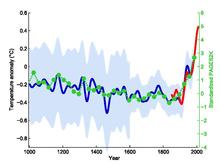| Revision as of 04:50, 17 August 2022 editDicklyon (talk | contribs)Autopatrolled, Extended confirmed users, Rollbackers477,756 edits rm unreffed math← Previous edit | Revision as of 05:00, 17 August 2022 edit undoDicklyon (talk | contribs)Autopatrolled, Extended confirmed users, Rollbackers477,756 edits image and change stub typeNext edit → | ||
| Line 12: | Line 12: | ||
| </ref> | </ref> | ||
| a hockey stick graph is one in which the "blade" is near zero (hugging the floor) before the graph turns upward to a long nearly straight increasing section. By contrast, in ], the well-known ] describing 1000 years of global or hemispheric temperature has the "handle" horizontal and "blade" turning upward. | a hockey stick graph is one in which the "blade" is near zero (hugging the floor) before the graph turns upward to a long nearly straight increasing section. By contrast, in ], the well-known ] describing 1000 years of global or hemispheric temperature has the "handle" horizontal and "blade" turning upward. | ||
| [[File:T comp 61-90.pdf|thumb|left|The northern hemisphere hockey stick graph of Mann,<ref> | |||
| {{Citation | |||
| |last1= Mann | |||
| |first1= Michael E. | |||
| |last2= Bradley | |||
| |first2= Raymond S. | |||
| |last3= Hughes | |||
| |first3= Malcolm K. | |||
| |year= 1999 | |||
| |title= Northern hemisphere temperatures during the past millennium: Inferences, uncertainties, and limitations | |||
| |journal= Geophysical Research Letters | |||
| |volume= 26 | |||
| |issue= 6 | |||
| |pages= 759–762 | |||
| |doi= 10.1029/1999GL900070 | |||
| |url= http://www.meteo.psu.edu/holocene/public_html/shared/research/ONLINE-PREPRINTS/Millennium/mbh99.pdf | |||
| |bibcode= 1999GeoRL..26..759M | |||
| |doi-access= free | |||
| |access-date= 25 March 2013 | |||
| |archive-date= 13 May 2013 | |||
| |archive-url= https://web.archive.org/web/20130513172624/http://www.meteo.psu.edu/holocene/public_html/shared/research/ONLINE-PREPRINTS/Millennium/mbh99.pdf | |||
| |url-status= dead | |||
| }}</ref> | |||
| smoothed curve shown in blue with its uncertainty range in light blue, overlaid with green dots showing the 30-year global average of the 2013 reconstruction. The red curve shows measured global mean temperature, according to ]4 data from 1850 to 2013.]] | |||
| ==See also== | ==See also== | ||
| Line 22: | Line 47: | ||
| ] | ] | ||
| {{ |
{{econ-stub}} | ||
Revision as of 05:00, 17 August 2022

A hockey stick graph or hockey stick curve is a graph, or curve shape, that resembles an ice hockey stick, in that it turns sharply from a nearly flat "blade" to a long "handle". In economics, marketing, and dose–response relationships, a hockey stick graph is one in which the "blade" is near zero (hugging the floor) before the graph turns upward to a long nearly straight increasing section. By contrast, in climate science, the well-known hockey stick graph (global temperature) describing 1000 years of global or hemispheric temperature has the "handle" horizontal and "blade" turning upward.

See also
References
-
Society of Plastics Engineers. Technical Conference Proceedings, Part I. Society of Plastics Engineers. 1985. Retrieved 17 August 2022.
The hockey-stick graph, which shows a magnificent turnaround in our business starting tomorrow, is familiar to all. This is partly the fault of marketing managers who, by nature, tend to be optimists; but it is also the fault of top management, who will not accept any project that promises less than spectacular results.
- Taylor, John B. (1995). Economics. Houghton Mifflin. p. 33. ISBN 9780395660300. Retrieved 17 August 2022.
The long handle of the hockey stick is the sharp increase in the debt in the 1980s and 1990s. The part of the hockey stick that you hit the ball or puck with represents slower increases ...
-
Halfmill, Tom (July 1999). "Who Will Wire Your Home?". Maximum PC: 37. Retrieved 17 August 2022.
As usual, industry pundits are trotting out their all-purpose hockey-stick graphs to show that home networking will soon be a huge market.
-
"Estimation of safe doses: critical review of the hockey stick regression method". Environmental health perspectives. 32: 193–199. 1979. Retrieved 17 August 2022.
The hockey stick regression method is a convenient method to estimate safe doses, which is a kind of regression method using segmented lines.
{{cite journal}}: Unknown parameter|authors=ignored (help) - Cornfield, Jerome (18 November 1977). "Carcinogenic Risk Assessment". Science. 198 (4318): 693–699. Retrieved 17 August 2022.
A simplified model in which a toxic substance is activated and deactivated in separate and simultaneous reactions is presented and the dose response curve implied by the model is deduced. This curve has the general form of a hockey stick, with the striking part flat or nearly flat until the dose administered saturates the deactivation system, after which the probability of a response rises rapidly.
- Mann, Michael E.; Bradley, Raymond S.; Hughes, Malcolm K. (1999), "Northern hemisphere temperatures during the past millennium: Inferences, uncertainties, and limitations" (PDF), Geophysical Research Letters, 26 (6): 759–762, Bibcode:1999GeoRL..26..759M, doi:10.1029/1999GL900070, archived from the original (PDF) on 13 May 2013, retrieved 25 March 2013
This economics-related article is a stub. You can help Misplaced Pages by expanding it. |